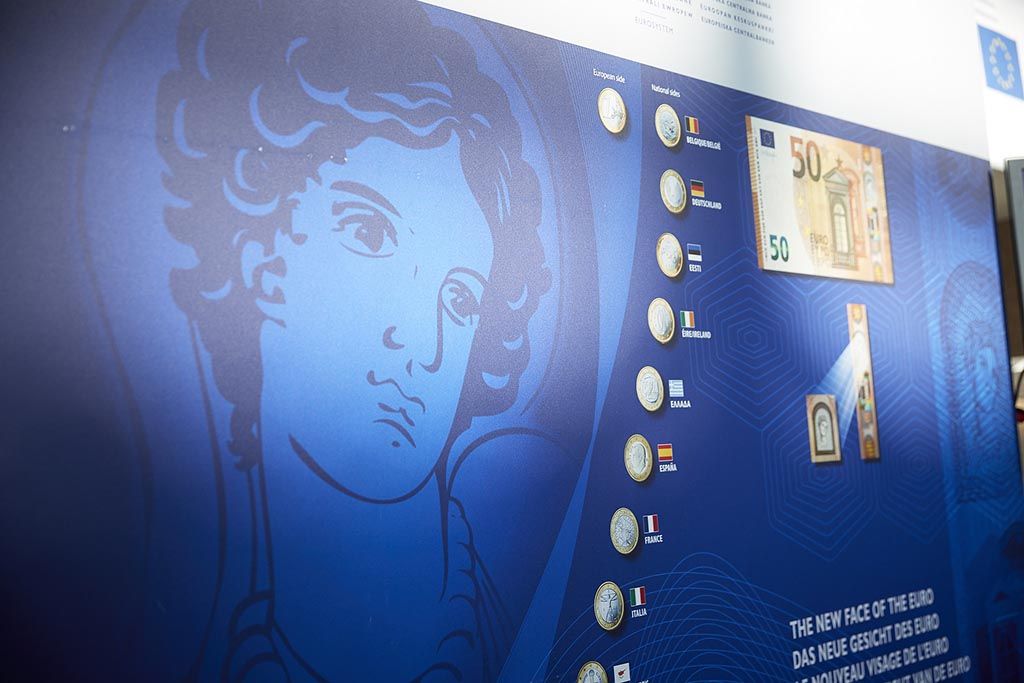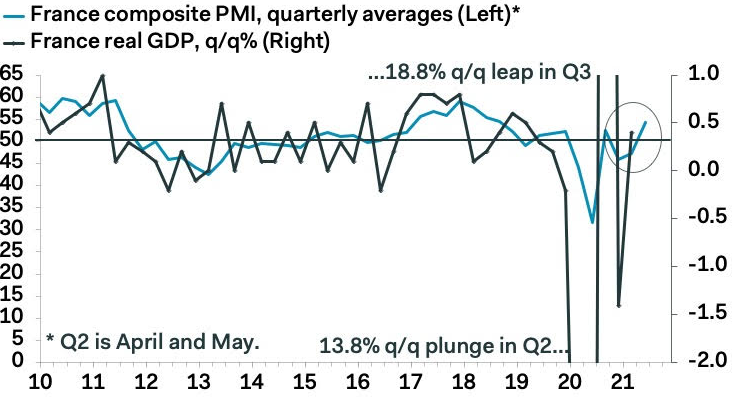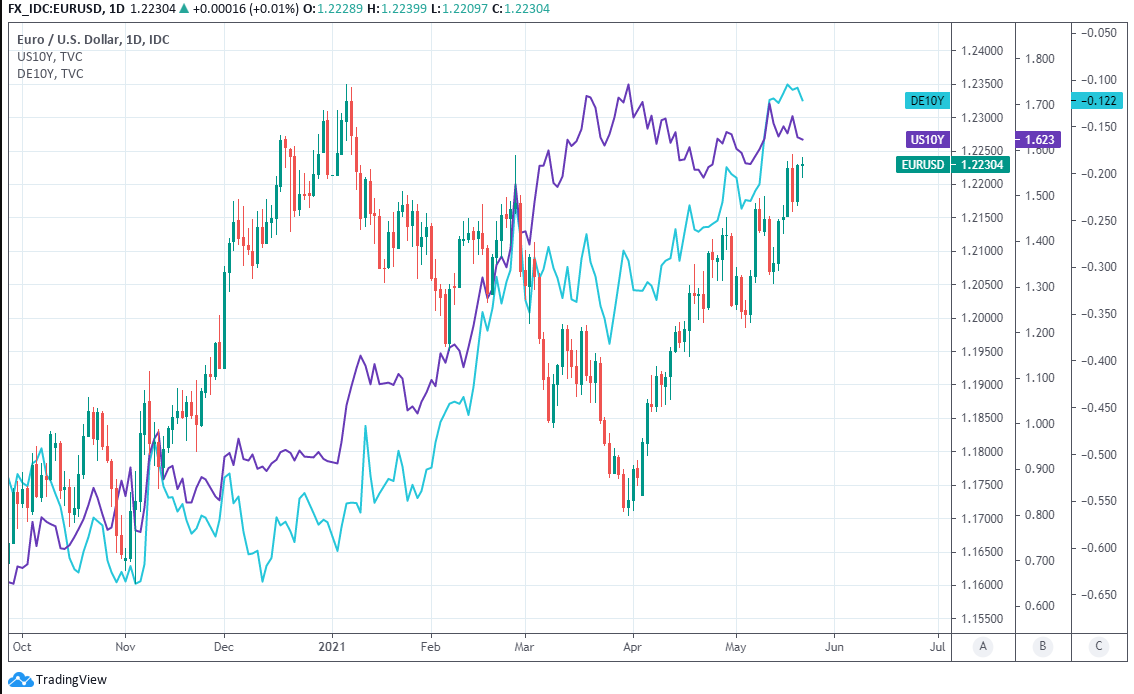Euro-Dollar Analysts Eye 1.25+ as PMIs Signal Return to Growth
- Written by: James Skinner
- EUR/USD on track for 1.25 in summer
- Key industries return to growth in May
- Led by France, aided by Germany et al
- Fires starting pistol on Q2 recovery race

Image © European Central Bank
- EUR/USD reference rates at publication:
- Spot: 1.2232
- Bank transfers (indicative guide): 1.1803-1.1890
- Money transfer specialist rates (indicative): 1.2121-1.2145
- More information on securing specialist rates, here
- Set up an exchange rate alert, here
The Euro-Dollar exchange rate was looking higher from the recently reclaimed 1.22 level on Friday after IHS Markit PMI surveys suggested that key continental industries returned to growth in May, effectively firing the starting pistol on an economic recovery that some analysts see taking the single currency to 1.25 this summer.
Europe’s single currency had already recovered 1.22 ahead of the release, its highest since late February, but was attempting to pull away from the level after surveys of the manufacturing and services sectors surprised on the upside for the month of May.
Indices measuring an agglomeration of indicators suggested that Germany’s services sector returned to growth this month while activity among manufacturers cooled, albeit with activity and output from the latter industry having reached record highs already in recent months.
But it was French industry which surprised most and contributed the lion’s share to an upturn in PMI indices for the Eurozone as a whole, with the French services PMI rising to one of its strongest levels for years while manufacturers benefited both from a loosening of restrictions on activity at home as well as recoveries elsewhere.
“These numbers are robust, though slightly less stellar than in France,” says Claus Vistesen, chief Eurozone economist at Pantheon Macroeconomics, referring to German PMIs. “The chart shows that GDP growth in France rebounded in Q1, and judging by the PMIs, and the improving trend in virus cases, the economy will build on this gain in Q2."
Above: Pantheon Macroeconomics graph showing French PMI surveys alongside real GDP growth.
Secure a retail exchange rate that is between 3-5% stronger than offered by leading banks, learn more.
France’s manufacturing PMI rose from 58.9 to 59.2 this month - a record high - while the services sector may have returned to growth with the PMI rising comfortably above the 50 level which indicates the difference between industry expansion and contraction for the first time since July last year.
For the Eurozone overall, manufacturing industry recoveries levelled off this month with the IHS PMI edging down from a record high of 62.9 to 62.8, although just like in France and Germany the continent’s services sector appeared on course for a return to growth.
The services PMI rose from 50.5 last month to 55.1 in May coinciding with a tentative easing of restrictions on activity across some of the bloc’s major economies and burnishing economists’ hopes that the current quarter will bring about a sustainable return to growth.
“Supported by an aggressive monetary stimulus, an adequate fiscal response and strong global demand, Europe is on track for a solid rebound from the Covid-19 recession. As the winter wave of the pandemic is receding, the gradual relaxation of restrictions is underpinning a rapid recovery in the services sector on top of exceptional growth in manufacturing,” says Holger Schmieding, Chief Economist at Berenberg.
The Euro-to-Dollar rate attempted to pull away from 1.22 as the U.S. Dollar index headed back toward 2021 lows in the wake of the release on Friday, drawing a line under earlier weakness seen when the Dollar surged following the release of minutes from April’s Federal Reserve (Fed) policy meeting on Wednesday.
Above: Euro-Dollar rate shown at hourly intervals alongside U.S. Dollar Index.
{wbamp-hide start} {wbamp-hide end}{wbamp-show start}{wbamp-show end}
“Last week we shifted our expected EURUSD range for the rest of Q2 to 1.1950 to 1.2350. As things stand, a test of the higher level looks on the cards very soon. For our range top to hold in the absence of a change in Fed stance, we would likely need to see euro area 5y5y inflation expectations peak out ahead of the 1.70% levels that were typical in 2017-2018,” says Shahab Jalinoos, head of FX strategy at Credit Suisse.
The Dollar had surged and the Euro as well as other currencies tumbled when minutes of the Fed's April meeting suggested that at least some U.S. rate setters thought it could be appropriate at some point in the months ahead to begin a discussion about when might be the best time to begin winding down the bank’s $120bn per month quantitative easing programme.
That would mean higher U.S. bond yields which potentially bolster the appeal of the Dollar, especially in light of Washington’ plans to spend trillions more over the coming years on infrastructure and other initiatives in addition to pandemic-related spending.
But with this week’s brief Fed-induced foray higher on the charts aside, it’s European government bond yields and the Euro that have been the focus of investors’ attention after recovery hopes were seen lifting German government bond yields back toward zero and levels not seen since early 2019.
“In contrast to treasuries the euro has shown greater sensitivity to movements in European yields. There is a strong non-linearity in the relationship between FX and interest rate differentials with the EUR turning very responsive to bund yields when they cross zero,” says George Saravelos head of FX research at Deutsche Bank, who forecasts a Euro-Dollar rally to 1.25 by the end of September.
“Positive bund yields and a potential ECB taper provide asymmetric risks for the euro and will further highlight monetary policy divergence compared to a delayed Fed taper,” he says.
Above: Euro-Dollar rate shown at daily intervals with 10-year U.S. and German bond yields.






